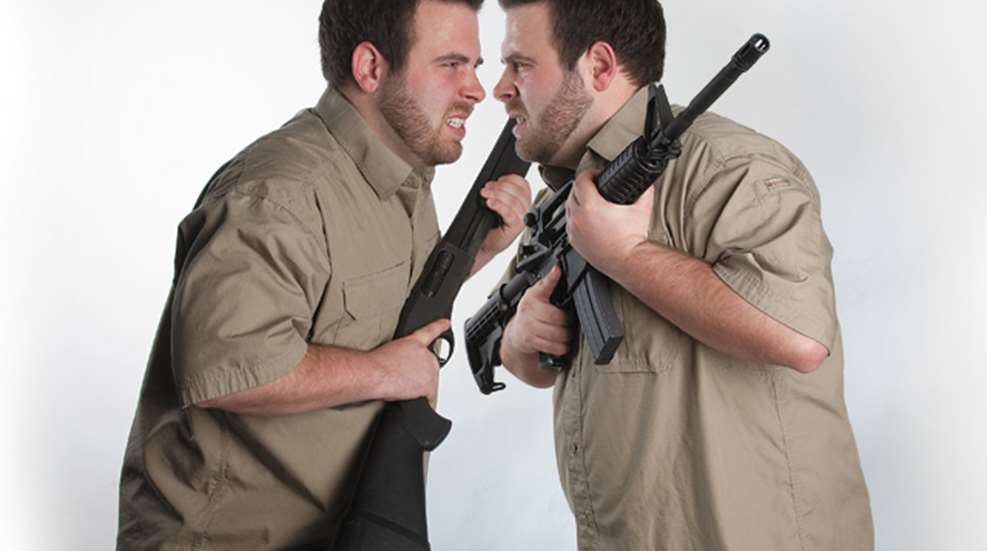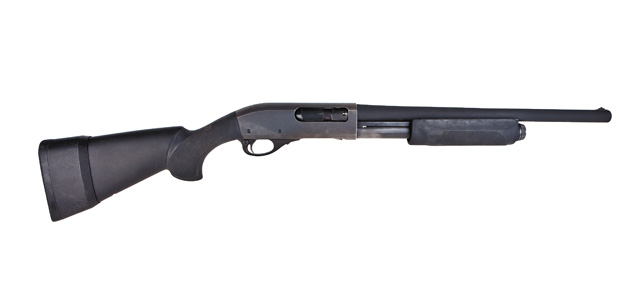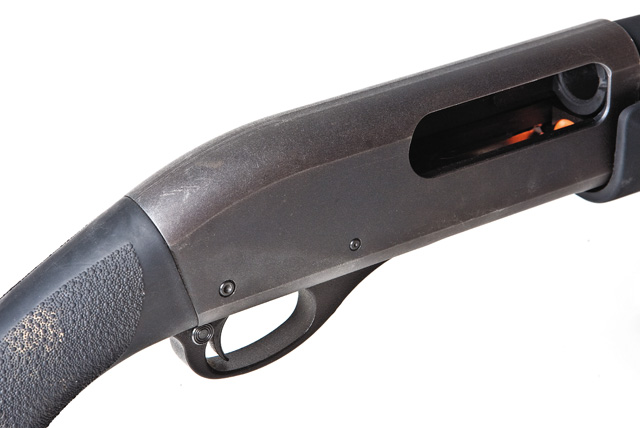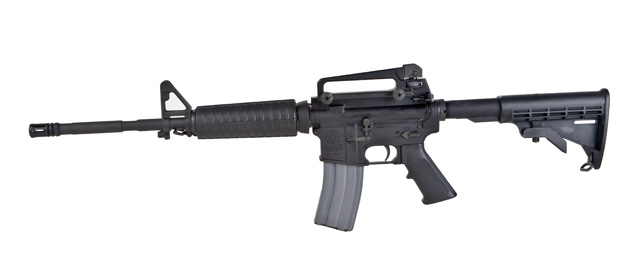
All across the nation, the evening shifts of countless police agencies are assembling their gear, getting briefed and uniformed to start their patrols. With only a few exceptions, there is a long gun racked up in the front seat of their patrol cars. More often than not, that gun is a Remington Model 870, the 60-year-old 12-gauge shotgun that has been the mainstay of police forces for decades. But in some cars, there is a different gun in place. It is a version of the AR-15 with a short barrel and a long magazine. Which officer has an advantage?
The service version of the AR-15 carbine is called an M4—although technically that term applies only to the Colt-produced gun. In law enforcement, the AR-15s are almost always semi-autos with 16-inch barrels. The use of these .223 Rem. carbines is a fairly recent phenomenon that stems from situations where greater range capability than that of a shotgun is required.
Although there are still countless thousands of short police 12-gauge shotguns like the 870 in use, it is clear AR-15s are making big inroads. I have to wonder how many M4s made it to the front-seat rack on the basis of careful reason and how many came by way of the understandably human desire for change—or even because of the M4's greater cool quotient. After all these years, the venerable old trouble gun—a short shotgun—is often augmented, if not replaced, by the modern .223 AR-15 carbine. The carbine is often viewed as a better firearm due to greater accuracy and range, a perception that is undeniably true. A spin-stabilized spitzer-type bullet traveling at very high velocity is much more likely to arrive where it is aimed when the target is distant. However, a charge of 00 buck or 000 buck, or even a 1-ounce slug, has a greater chance of completing its mission—to stop the fight immediately—than a 55-grain, .22-caliber bullet.

I could take either side of the argument and make a good case for personal defense. No matter what conclusion I might reach, however, there is no scientific measurement involved. So, I decided to try to actually measure the effectiveness of the two guns in a side-by-side shootout. For my shootout to have any validity in its results, the playing field would have to be as level as possible—the same challenges needed to be presented to both guns. Since the crux of the matter was effectiveness at range, I determined each gun should be fired at the same target and at the same range. Because the idea was to ascertain some kind of combat effectiveness under stress, I put a time limit on each stage. To establish a baseline from which to compare guns, I used plain, uncustomized versions of the 870 shotgun and M4 carbine. In recent years, the 870 shotgun has come to be heavily customized by individual shooters and the AR is like the 1911 pistol in being one of the most heavily user-modified guns in the arsenal. Brownells devotes endless pages to thingamajigs and whoozits for the AR in its catalog.
To do the shooting, I went to Gunsite Academy near Prescott, AZ, where I engaged the assistance of Operations Manager Ed Head. I was fortunate a 260 Shotgun course was in progress, as well as a 223 Carbine course. For the purposes of the test, I needed a really good shooter for each gun. Head suggested Bill Murphy as the shotgunner.

Murphy is a friend from my first visit to Gunsite many years ago. He is still a working police officer with a Southern California agency and has been involved with SWAT, felony arrest and other police special operations work for his entire 20-year career. A Gunsite Rangemaster, Murphy is a highly skilled tactical shooter who has actual police shooting experience with several platforms. Vince Morgan, his counterpart with the AR-15, is a Midwestern police officer who was at Gunsite polishing his instructional and tactical skills. Morgan is also a longtime law enforcement officer with considerable field experience—another shooter who has seen the elephant and heard the owl.
The actual course of fire for our experiment was as follows. Each shooter faced a single Gunsite silhouette, first at 15 yards, then 25, 50, 75 and 100 yards. On the whistle, they had 3 seconds to get as many hits as possible on the target. Obviously, the shotgun has the potential for many more hits, but the carbine was more likely to get hits at the greater ranges. Since we used stock guns—a plain 18-inch, cylinder-bore 12-gauge 870 and a Smith & Wesson M&P15—that neither shooter had handled or fired before, there was no advantage to shotgunner or rifleman.
Murphy was at a tremendous disadvantage, because in its stock configuration, the 12-gauge shotgun didn't contain a rear sight. He had to shoot using the rear edge of the receiver for a sighting reference. It might seem unfair, but most patrol-car shotguns just don't have rear sights.

Scoring was interesting. In a sense, we were trying to evaluate the performance of two vastly different systems, and computing the energy each gun delivered to the target at each range was the best means of comparison. To accomplish this, I had to determine the weight of the bullet or pellet and the speed at which it was traveling when it struck the target, calculate the energy at impact, then multiply by the number of hits the shooter produced. Thus, Morgan's first stage at 7 yards saw his four, 55-grain bullets traveling at 3,240 fps produce 1,282 foot-pounds each, for a total of 5,128 foot-pounds. Yet, I remain a shooter who is distrustful of energy as a definitive index of stopping power. In my view, the means of energy transmission to the target should always be considered.
I also gave the shooters the option of choosing their ammunition and several types were available. This was most important to the shotgunner, who could use either buckshot or slugs. The slugs available were Federal Law Enforcement 1-ounce slugs of the Foster type. A slug load in a fighting shotgun is a much underappreciated piece of ordnance. It is essentially a .73-caliber, soft-lead hollow-base bullet weighing 437 grains, traveling 1,325 fps at 25 yards.
Close in, a slug generates more than 2,000 foot-pounds of energy, about five times that of a .45 ACP. Even at 50 yards, one of Murphy's slugs had about three times the energy of one of Morgan's 55-grain AR-15 rounds. It is well understood in combat shooting circles that a solid torso hit with a shotgun slug instantly stops the fight.
My personal-defense shoot had a lot of warts on it, but the test crew plunged enthusiastically forward. I guessed Murphy would probably use buckshot at 15 and 25 and slugs the rest of the way. I was wrong. He used slugs at 15, getting four hits in 3 seconds. So did Morgan with his AR-15. Murphy was well aware of what he could do with slugs at close range, so he shot for as high an energy level as possible. At 25 yards, he hedged his bets a bit. Knowing a cylinder-bore shotgun will reliably keep almost all of its pellets (in a nine-pellet #00 load) on a silhouette at 25 yards, he used buckshot. Firing four rounds and getting 35 hits out of the 36 possible, Murphy did not risk a miss with slugs.
At 50 yards, Murphy went back to his slugs and stayed with them the rest of the way. He only managed two hits at 50 yards, one at 75 and then two at the 100-yard line. But, Morgan—as solid and reliable a shooter as I have ever watched—got five hits at 50, then four at 75 and finished with three at 100 yards.
Slugs are amazing projectiles in many ways. Even in an unchoked or unrifled barrel, they can be remarkably accurate all the way to 100 yards and beyond. But, that big old punkin' ball has a poor excuse for a ballistic coefficient and drops in velocity fast. Since energy is calculated using the square of velocity, when a projectile quickly sheds velocity, energy decays even faster. In plain terms, the shotgun put more energy on target than the rifle, at least inside of 50 yards. But at that range, the AR-15 started to excel. Basically, that's because the nature of rifle ballistics are such that rifle bullets retain energy much longer and are markedly superior in the accuracy department. Compound the shotgunner's problem with a nearly non-existent sighting system and he doesn't have much of a chance.
Does my personal-defense shootout prove anything? Actually, it does not. A statistician would tell you there is insufficient data. All we really have here is a suggestion that the conclusions are meaningful. Murphy was aware of this and wanted to see what he could do with slugs in his own 12-gauge shotgun, a Mossberg auto-loader with a modern red-dot sight. I asked Morgan to shoot against him using his own AR, a Colt M4 with another red-dot sight. They fired the 3-second drill at 50 yards. Murphy's shotgun delivered three hits for 4,266 foot-pounds of energy, but Morgan was able to speed up thanks to his red dot, getting seven hits for 8,218 foot-pounds. As it was with the uncustomized guns, the AR-15 got more power on target. This will not come as a big surprise to any experienced field shooter. The shotgun would seem to have lost, but because inferior sights caused a severe limitation on getting hits.
I would not argue for dumping all 12-gauge shotguns. It is relatively easy to put a set of rugged ghost rings on the Remington and it does wonders for the gun's accuracy—even at close range. Also, I remain convinced a hit with a shotgun slug or a charge of buckshot is a better hit than one from a .223 Rem. AR-15 bullet—it tends to traumatize more tissue. At 100 yards, the delivered energy from a 1-ounce slug is about 970 foot-pounds. The .224-inch-diameter bullet is more than 1,000—not a lot of difference. If anything comes out of this experiment, it is a strong recommendation to to put better sights on shotguns and investigate the wider use of slugs.




































